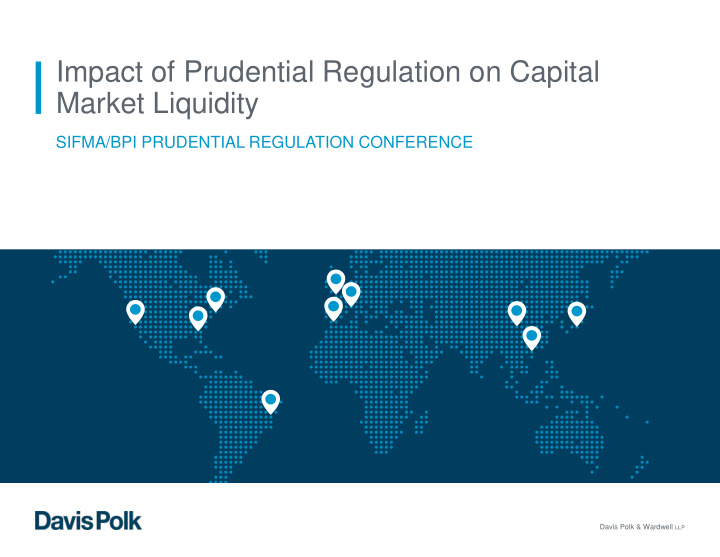



Impact of Prudential Regulation on Capital Market Liquidity SIFMA/BPI PRUDENTIAL REGULATION CONFERENCE Davis Polk & Wardwell LLP
Today’s Question Section 13(3): Does prudential regulation affect market liquidity? If so, how? 1
Unclear Effects of Regulation on Market Liquidity “Quantifying the effects of the regulatory reforms is challenging for several reasons. Most notably, overlapping implementations make it difficult to isolate the effect of any single rule or requirement…It is also possible that many of the observed changes in market participant behaviors would have occurred absent the reforms…Finally, post reform macroeconomic conditions…are different from those leading up to and right after the financial crisis.” “Evidence for the impact of regulatory reforms on market liquidity is mixed, with different measures of market liquidity showing different trends.” Source: Report to Congress, Access to Capital and Market Liquidity , Division of Economic and Risk Analysis of the SEC, August 2017 2
Empirical Evidence STUDIES ANALYZING VOLCKER RULE AND LCR REACH SIMILAR CONCLUSIONS 1. Regulations cause affected institutions to provide less liquidity, particularly in times of stress 2. Non-affected institutions step in to provide liquidity, but not enough to offset – there is a net loss of market liquidity Increased Price Volatility: Source: Bao, O’Hara, and Zhou, The Volcker Rule and corporate bond market Source: Roberts, Sarkar, Shachar, Bank Liquidity Provision and Basel Liquidity making in times of stress , Journal of Financial Economics, June 2017 Regulations , Federal Reserve Bank of New York, June 2018 3
Impact of Prudential Regulation on Capital Market Liquidity SIFMA/BPI PRUDENTIAL REGULATION CONFERENCE Davis Polk & Wardwell LLP
The Volcker Rule
Proprietary Trading 6
Market Making Exemption 7
Market Making Exemption: Key Requirements • The trading desk routinely stands ready to purchase and sell the financial instrument and is willing and available to quote, purchase and sell those types of financial instruments in commercially reasonable amounts and throughout market cycles as is appropriate based on the liquidity, maturity and depth of the market for the relevant financial instruments. • The trading desk’s market maker inventory must be designed not to exceed, on an ongoing basis, the reasonably expected near-term demands of clients, customers or counterparties (“RENT - D”) − The exemption requires a demonstrable analysis of historical customer demand, current inventory of financial instruments, and market and other factors regarding the amount, types, and risks, of or associated with financial instruments in which the trading desk makes a market, including through block trades. 8
Impact on Market Liquidity: Theory 9
Impact on Market Liquidity: Theory Source: Oliver Wyman, The Volcker Rule Restrictions on Proprietary Trading: Implications for Market Liquidity (2012) 10
Impact on Market Liquidity: Empirical Evidence Jack Bao, Maureen O’Hara and Xing (Alex) Zhou, The Volcker Rule and Corporate Bond Market Making in Times of Stress , 130 J. Fin. Econ. 95 (2018) “ We show that liquidity provision by Volcker-affected dealers dropped during post-Volcker stress times and [liquidity provision] by non-Volcker- affected dealers has not increased enough to compensate for this decline .” 11
Effect of Proposed Rules Proposed Accounting Prong: “ Trading account means any account that is used by a banking entity to … purchase or sell one or more financial instruments, with respect to a financial instrument that is recorded at fair value on a recurring basis under applicable accounting standards.” 12
Recommend
More recommend